Rome is home to one of the most remarkable ancient temples in the world.
Unlike Roman monuments such as the Colosseum or the Circus Maximus, the Pantheon has been preserved remarkably well for almost 2,000 years, mainly because it was converted to a Catholic church.
This ancient architectural miracle has a lot of stories to tell, and in this post, you’ll discover the ultimate list of facts about the Pantheon.
1. What is the Pantheon?
The Pantheon was an ancient Roman Temple that has been converted into a church dedicated to “St. Mary and the Martyrs,” commonly referred to as “Santa Maria Rotonda.”
The reason it has been preserved so well is because of this conversion and its continuous use as a result of this.
One of the most interesting facts about the Pantheon is that it was unique in Roman architecture. Nowhere else in ancient Rome was a temple built with a circular dome and a common temple portico as the front.

2. What does the word Pantheon Mean?
The word Pantheon comes from the Ancient Greek “Pantheon ” which means “to all the Gods.”
The exact reason it was called this way isn’t too clear. A Roman senator named “Cassius Dio” ( 155 – 235 A.D.) believed it had either to do with statues of gods that were once placed around the temple or to the dome that resembles heaven.
The latter would make sense considering the uniqueness of the temple’s architecture in ancient Rome.

Another speculation was that “Pantheon” actually wasn’t the name of the temple at all but rather a nickname.
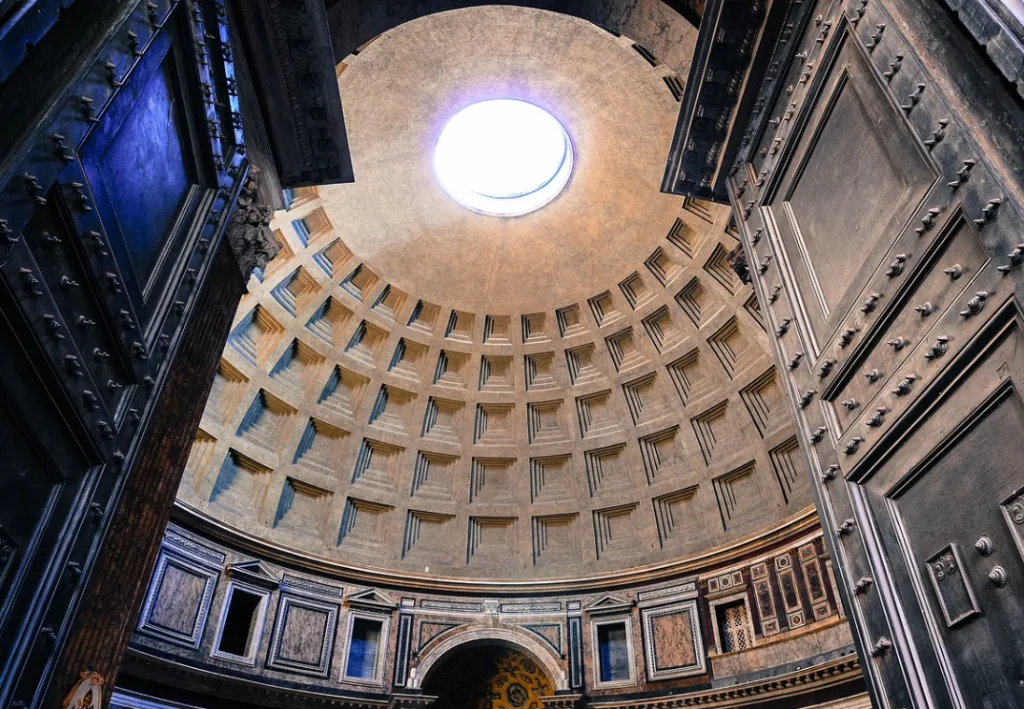
3. When was the Pantheon Built?
The battle of Actium fought in 31 B.C. was epic. It was the battle between Octavian (later known as Augustus) and the combined forces of Mark Anthony and Queen Cleopatra of Egypt that turned the Roman Republic into the Roman Empire.
To celebrate, Roman statesman Marcus Vipsanius Agrippa, a close friend of Octavian, decided to create some amazing buildings on his property the “Campus Martius.” This happened between 29 and 19 B.C.
One of them was the Pantheon.
The first version burned down around 80 A.D. but it was rebuilt. The second version burned down as well.
The final version was built by Roman Emperor Hadrian around 118-125 A.D.

4. When did the Pantheon become a church?
It was Byzantine emperor Phocas who gave away the Pantheon to Pope Boniface IV who promptly converted it into a Christian church.
Pope Boniface IV consecrated it to St. Mary and the Martyrs on 13 May in the year 609 A.D.
Because the Pantheon had become a Christian church, it was mostly spared from the destruction similar buildings suffered during the early Middle Ages.
An interesting fact about the Pantheon: There is a Catholic mass every Sunday and on holy days, and it sometimes even holds weddings!

More interesting facts about the Pantheon
5. The date of construction of the Pantheon is actually unknown. It is believed to be inaugurated in 126 A.D. under the reign of emperor Hadrian. The reason it’s unknown? Because Hadrian decided to keep the inscription of Agrippa on the temple rather than using his own. Since the old one burned down, we can’t be exactly sure when Hadrian laid the first and last stone of the final version of the Pantheon.
6. The letters on top of the portico of the Pantheon read:
Marcus Agrippa Lucii filius consul tertium fecit
This translates to: “Marcus Agrippa, son of Lucius, Consul for the third time, built this.” So this is a clear reference to the first version of the Pantheon which was built by Marcus Agrippa.
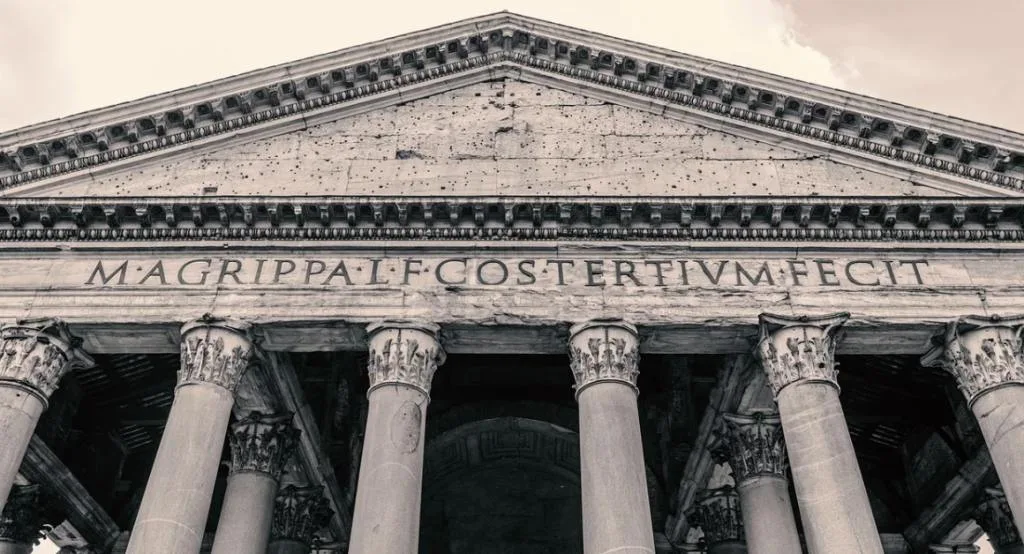
7. The portico of the Pantheon consists of large Corinthian pillars. The first row has 8 columns and there are 2 more rows behind that, each containing 4 columns.
8. The amazing dome also referred to as the “Rotunda,” was the largest one to have ever been built in the ancient world. Better yet, never before had a dome been built that didn’t use reinforced concrete.
9. The dome of the Pantheon is about 43.3 meters (142 ft) in diameter. This means that the dome still holds the record of being the largest dome in the world that doesn’t use reinforced concrete.
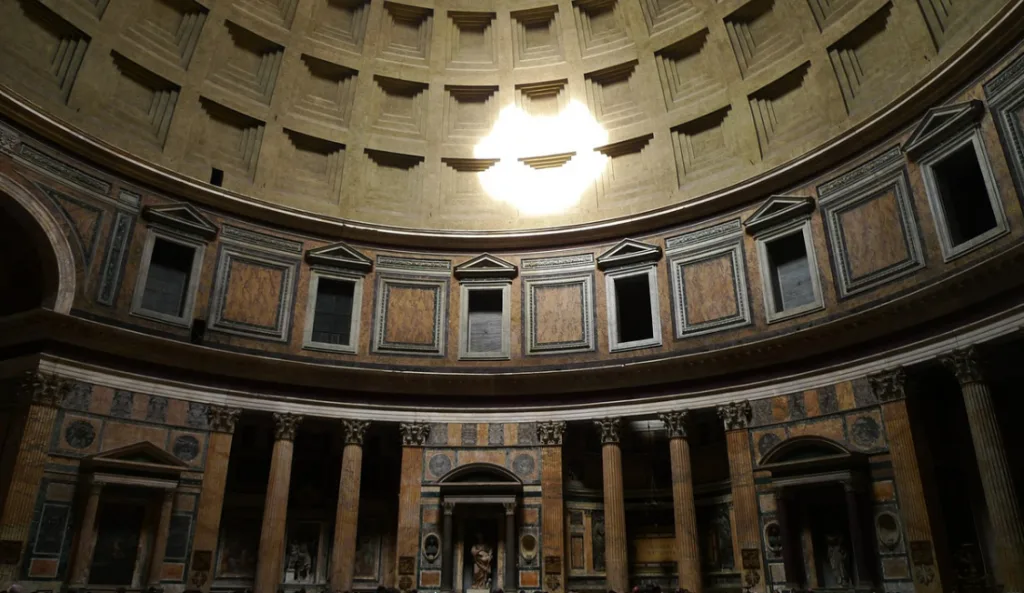
10. There is a big hole in the ceiling of the dome called the “oculus” which is 9.1 meters (30 ft) in diameter. This and the front door are actually the only way natural light can enter the dome.
11. So is the massive dome of the pantheon supported without using reinforced concrete? The reason is that the thickness of the dome at the base is much bigger than at the top near the oculus. At the base, it’s about 6.4 meters (21 ft) and at the top only 1.2 meters (3.9 ft). This relieves the pressure of the dome as the thickness decreased the higher it goes.
12. the word “oculus” is actually Latin for “eye.” this could be the reason it was called the “Pantheon” as we are symbolically looking into heaven to see “all the gods, ” which is what the word Pantheon means.
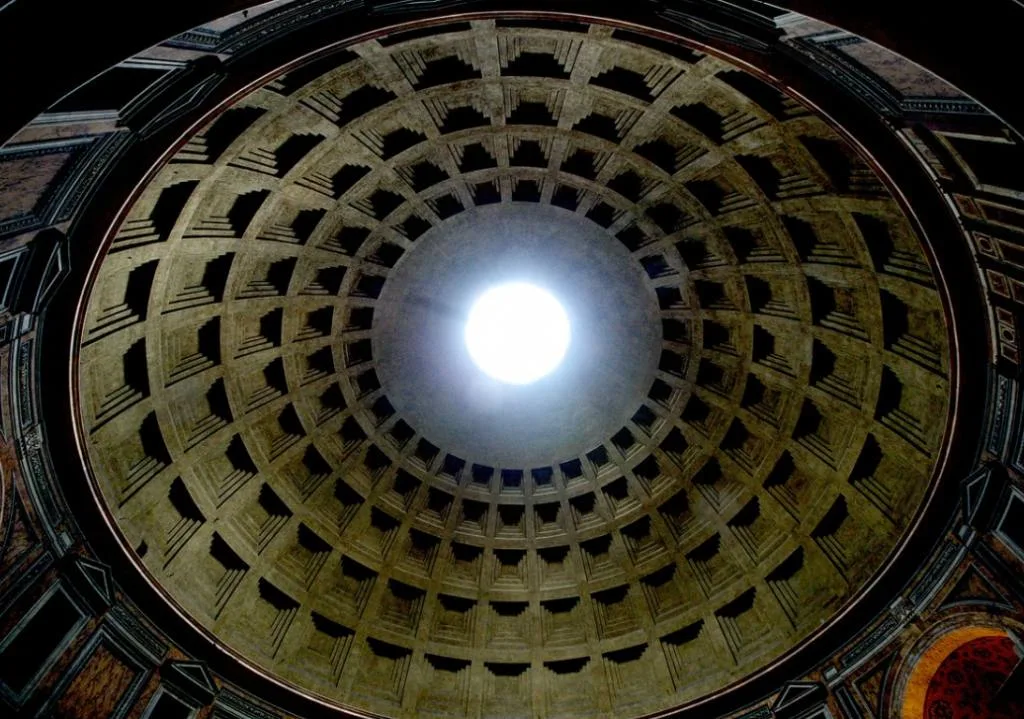
13. Because of the oculus, there is also the problem of rain coming down through the ceiling and onto the floor. Because of this, drainage was built and the floor of the dome has an incline of about 30 centimeters (12 in), allowing the water to run off and out of the building.
14. Some believe that the oculus, and therefore the entire Pantheon, is actually a gigantic sundial. Scholars Robert Hannah and Giulio Magli provide evidence that the sun is doing something interesting during equinoxes.
On April 21 around noon, anybody that stands into the open doorway of the Pantheon is basically standing in the spotlight. Whether or not this had a specific meaning, for example, this being the moment the emperor came into the Pantheon to glorify his divine power, remains unknown.

15. There isn’t a single modern-day engineer that would even consider creating a building like the Pantheon without using any reinforced steel. Even suggesting it would probably make you look like a complete fool. So why is the pantheon still standing after more than 2,000 years?
The answer lies in the mortar used during construction, which was a mix of volcanic ash and limestone. Because of this, over time Strätlingite crystals were formed that actually prevented microscopic cracks which would create a snowball effect towards further decay.
16. Remarkably, the height of the oculus and the diameter of the dome are the same, namely 43.3 meters (142 ft). This means that a giant sphere with a diameter of 43.3 meters could fit inside the room of the dome.

17. There seems to be an architectural mistake with the Pantheon. The portico contains 2 pediments, one with the Agrippa’s signature and one attached to the rotunda. The one attached to the rotunda is actually 4 meters (13.5 ft) higher than the first one. This mistake was intentional though as the pediments fit perfectly into the overall design of the Pantheon.
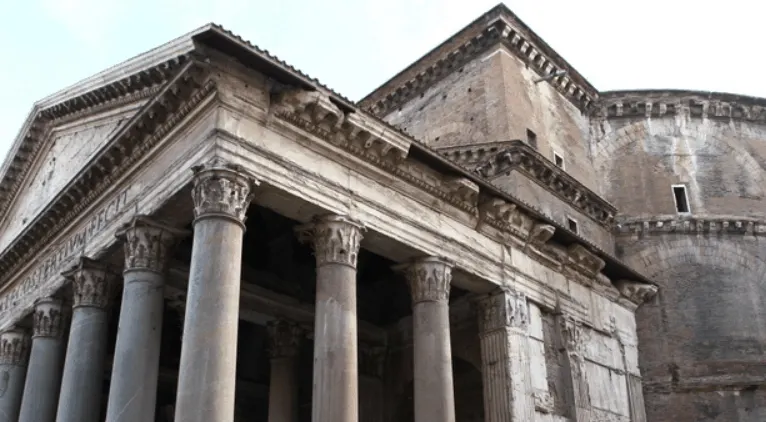
18. There is another, and far-fetched, theory though as to why these two pediments aren’t aligned. The second pediment is the exact height of the Obelisk standing on the square in front of the Pantheon. The first pediment is the same height as the obelisk in front of St. Peter’s Basilica.
19. The Pantheon wasn’t destroyed as it was converted into a church, but some losses have occurred though. One of the most notable was actually attributed to the Catholic Church themselves. Pope Urban VIII (1623 to 1644) ordered the stripping of the bronze from the ceiling of the portico of the Pantheon in the 17th century.
20. The bronze from the ceiling of the portico of the Pantheon was melted down and used to make cannons for the fortification of Castel Sant’Angelo, also known as “The Mausoleum of Hadrian.” Hadrian is the emperor that built the final version of the Pantheon and the Castel Sant’Angelo is where his ashes were kept (until they were scattered by the looting Visigoths in 410 A.D.

21. One of the most interesting facts about the Pantheon regarding its purpose (which still isn’t clear) is that it perfectly aligns with the Aubrey Holes, which are believed to have been constructed in the late fourth and early third millennium B.C., at Stonehenge, in Wilshire, England.
If we scale down the Aubrey Holes to half their size, we can see that they perfectly align with the walls of the Parthenon. Could it be true that both monuments did indeed have an astronomical role?
22. The dome of the Parthenon has a total weight of 4,535 tonnes, which is 4.535 million kilos, and is concentrated on a ring of voussoirs that form the oculus.
23. In another epic monument in Rome, the Colosseum, arches are also used to carry the weight of the structure. The Pantheon dome is built on a base of 8 barrel vaults that absorb the weight of the dome.

24. The tomb of famous Renaissance artist Raphael can be found in the Pantheon as he was buried there after his death in 1520. He was buried there at his own request
25. Remarkably, Raphael’s fiancee Maria Bibbiena, the niece of Cardinal Medici Bibbiena, a personal friend of Raphael, is buried next to him. This is remarkable because Raphael never really intended to marry her and rather got engaged to her to please his friend the Cardinal.
He got engaged in 1514 and never married her in the 6 remaining years of his life, seemingly finding enough excuses to postpone the wedding. During this period, he had a real love relationship with a baker’s daughter named Margherita Luti, who was also his model.

26. Raphael and his fiancee aren’t the only famous people that have been buried in the Pantheon. Two kings of Italy, Vittorio Emanuele II, and Umberto I, along with Umberto’s wife Margherita of Savoy also have their final resting place inside the Pantheon.
27. Do you like Pizza? Then you surely know the all-time classic “Margharita,” right? According to a legend, during a visit to Naples, the royal family wanted to eat a pizza. They summoned the best pizza maker in town named Raffaele Esposito, and he made a pizza that reflected the flag of Italy.
The pizza contained Tomatoes (red), Mozarella (white), and basil (green). She loved it so much that she wrote him a thank you letter, and to honor Queen Margherita, he named the pizza after her.

28. The original building actually had steps leading to the portico. In the final version of the Pantheon, the ground had been leveled which caused the steps to disappear.
29. The columns in the portico were actually quarried in the eastern desert of Egypt (which was a Roman province at that time) at Mons Claudianus. Moving these enormous columns, which are 11.9 meters tall, 1.5 meters in diameter, and weigh 60,000 kilos each, was a huge endeavor.
Ancient Romans didn’t have cranes, trucks, and highways to move these enormous objects. In Egypt alone, they were dragged for about 100 kilometers (62 mi) on wooden sleds from the quarry site to the river to be transported by boat.

30. Entering the Pantheon with its majestic dome is a surreal experience. One of the most famous artists of all time, Michelangelo, first laid eyes upon it in the early 1500s. He looked at everything from an artistic perspective and wasn’t easily impressed. He was so impressed that he called it:
Angelic and not human design.

31. Pope Urban VIII ordered the addition of two bell towers which were placed in between the first and second pediments. Carlo Maderno and Borromini were the designers of the “twin tower, ” not Bernini as some people wrongfully describe. Nobody really liked these and people started referring to them as “The ass’s ears.” They were demolished in 1883.

32. The Pantheon, strangely enough, faces north, even though it is believed that the original building might have faced south. This is, however, a point of debate and not a fact.
33. During the daytime, the light coming through the oculus actually has a reverse sundial effect.
34. The Pantheon has been a very influential building in Western architecture. The first building to have been modeled on the unique design of the Pantheon was the dome of the Cathedral of Florence. The dome of this cathedral was designed by Filippo Brunelleschi and completed in the year 1436.
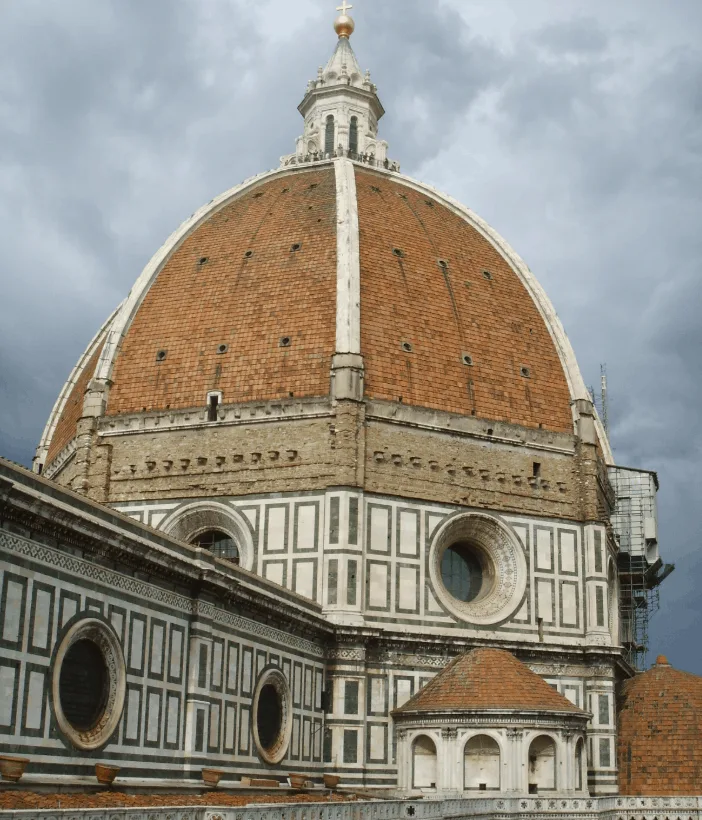
35. The influence of the design of the Pantheon wasn’t just limited to structures in Europe. “The Rotunda,” located in Charlottesville on the original grounds of the University of Virginia is the most famous example of a building inspired by the Pantheon in the United States. It was designed by Thomas Jefferson and construction started in 1822 and was finished in 1826.
36. Unfortunately, Thomas Jefferson wasn’t able to see the final version of the replica of the Pantheon he designed as he died shortly before it was completed on July 4, 1826.

37. There is actually a second inscription below the one created by Marcus Agrippa which is hardly noticeable. It refers to restorations done in 202 A.D. by Roman Emperor Septimius Severus and his son Caracalla. The text reads:
IMP[ERATOR] CAES[AR] L[UCIUS] SEPTIMIUS SEVERUS … ET IMP[ERATOR] M[ARCUS] AURELIUS ANTONINUS… PANTHEUM VETUSTATE CORRUPTUM CUM OMNI CULTU RESTITUERUNT
This translates to: “Emperor Lucius Septimius Severus… and Emperor Marcus Aurelius Antoninus… with each refinement, they restored the Pantheon, damaged by the passage of years.”

38. Millions of tourists visit the Pantheon in Rome every year. This used to be heaven for sellers of souvenirs. Unfortunately for them, the city government of Rome has banned the mobile shops located in front of historical monuments altogether. The ban has been in effect since January 1, 2020, and includes historical monuments such as the Colosseum, the Circus Maximus, the Spanish Steps, the Trevi Fountain, and many others.
39. Believe it or not but this recent ban hasn’t been the first time this has happened. In fact, back in the early 1800s, Pope Pius VII did a similar thing after the area around the Pantheon had turned into a complete mess caused by legal and illegal stores selling whatever they wanted. The Pope back then demolished everything and restored the area completely, just as it should be.

